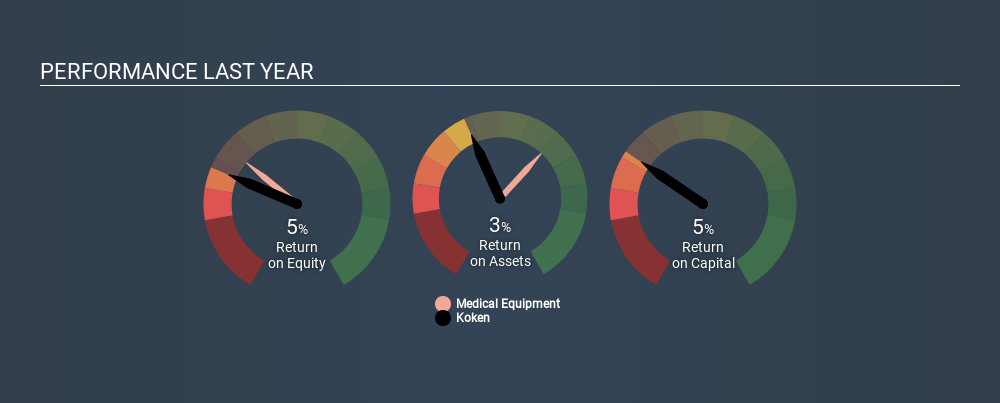- Japan
- /
- Medical Equipment
- /
- TSE:7963
Is Koken Ltd. (TYO:7963) Struggling With Its 5.3% Return On Capital Employed?

Today we'll look at Koken Ltd. (TYO:7963) and reflect on its potential as an investment. To be precise, we'll consider its Return On Capital Employed (ROCE), as that will inform our view of the quality of the business.
First of all, we'll work out how to calculate ROCE. Next, we'll compare it to others in its industry. And finally, we'll look at how its current liabilities are impacting its ROCE.
Return On Capital Employed (ROCE): What is it?
ROCE measures the 'return' (pre-tax profit) a company generates from capital employed in its business. All else being equal, a better business will have a higher ROCE. Ultimately, it is a useful but imperfect metric. Author Edwin Whiting says to be careful when comparing the ROCE of different businesses, since 'No two businesses are exactly alike.
So, How Do We Calculate ROCE?
The formula for calculating the return on capital employed is:
Return on Capital Employed = Earnings Before Interest and Tax (EBIT) ÷ (Total Assets - Current Liabilities)
Or for Koken:
0.053 = JP¥786m ÷ (JP¥19b - JP¥4.1b) (Based on the trailing twelve months to March 2020.)
So, Koken has an ROCE of 5.3%.
View our latest analysis for Koken
Does Koken Have A Good ROCE?
One way to assess ROCE is to compare similar companies. Using our data, Koken's ROCE appears to be significantly below the 10% average in the Medical Equipment industry. This performance is not ideal, as it suggests the company may not be deploying its capital as effectively as some competitors. Setting aside the industry comparison for now, Koken's ROCE is mediocre in absolute terms, considering the risk of investing in stocks versus the safety of a bank account. Readers may find more attractive investment prospects elsewhere.
You can click on the image below to see (in greater detail) how Koken's past growth compares to other companies.

It is important to remember that ROCE shows past performance, and is not necessarily predictive. Companies in cyclical industries can be difficult to understand using ROCE, as returns typically look high during boom times, and low during busts. ROCE is only a point-in-time measure. You can check if Koken has cyclical profits by looking at this free graph of past earnings, revenue and cash flow.
Koken's Current Liabilities And Their Impact On Its ROCE
Short term (or current) liabilities, are things like supplier invoices, overdrafts, or tax bills that need to be paid within 12 months. The ROCE equation subtracts current liabilities from capital employed, so a company with a lot of current liabilities appears to have less capital employed, and a higher ROCE than otherwise. To counter this, investors can check if a company has high current liabilities relative to total assets.
Koken has total assets of JP¥19b and current liabilities of JP¥4.1b. Therefore its current liabilities are equivalent to approximately 22% of its total assets. This is a modest level of current liabilities, which would only have a small effect on ROCE.
The Bottom Line On Koken's ROCE
With that in mind, we're not overly impressed with Koken's ROCE, so it may not be the most appealing prospect. But note: make sure you look for a great company, not just the first idea you come across. So take a peek at this free list of interesting companies with strong recent earnings growth (and a P/E ratio below 20).
If you are like me, then you will not want to miss this free list of growing companies that insiders are buying.
Love or hate this article? Concerned about the content? Get in touch with us directly. Alternatively, email editorial-team@simplywallst.com.
This article by Simply Wall St is general in nature. It does not constitute a recommendation to buy or sell any stock, and does not take account of your objectives, or your financial situation. We aim to bring you long-term focused analysis driven by fundamental data. Note that our analysis may not factor in the latest price-sensitive company announcements or qualitative material. Simply Wall St has no position in any stocks mentioned. Thank you for reading.
About TSE:7963
Koken
Produces and sells occupational personal protective and environment quality improvement equipment in Japan.
Excellent balance sheet with proven track record and pays a dividend.
Market Insights
Community Narratives




